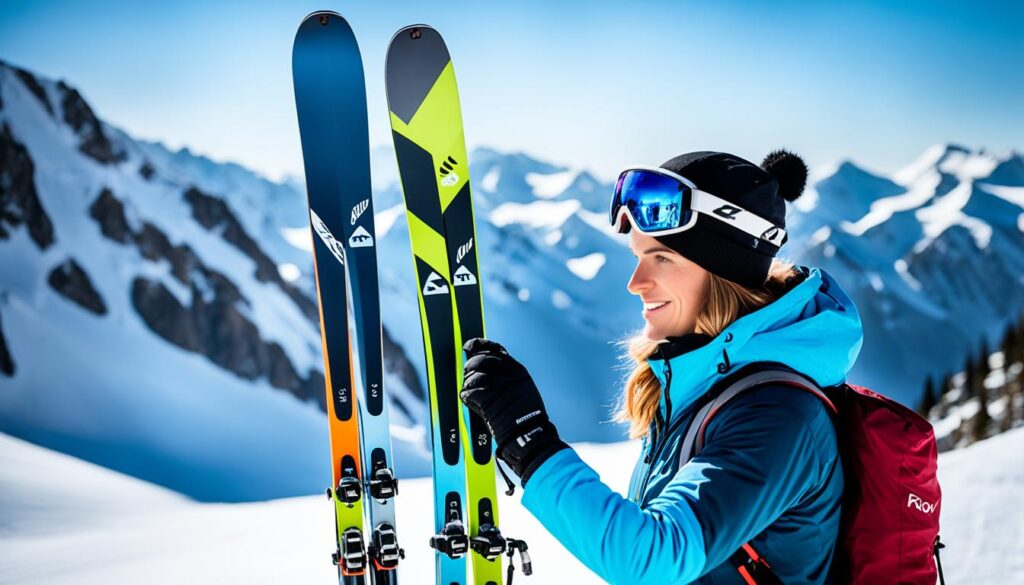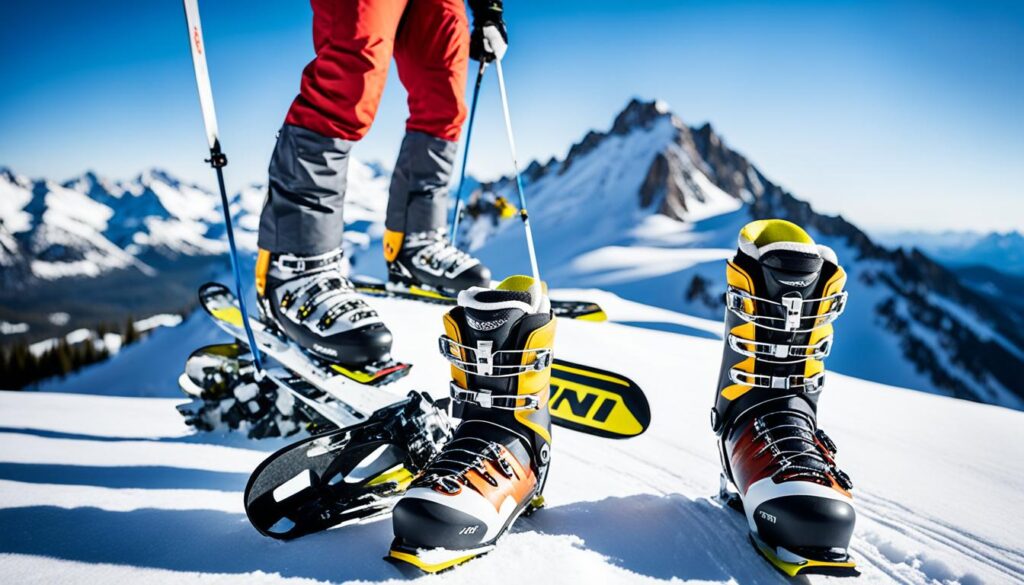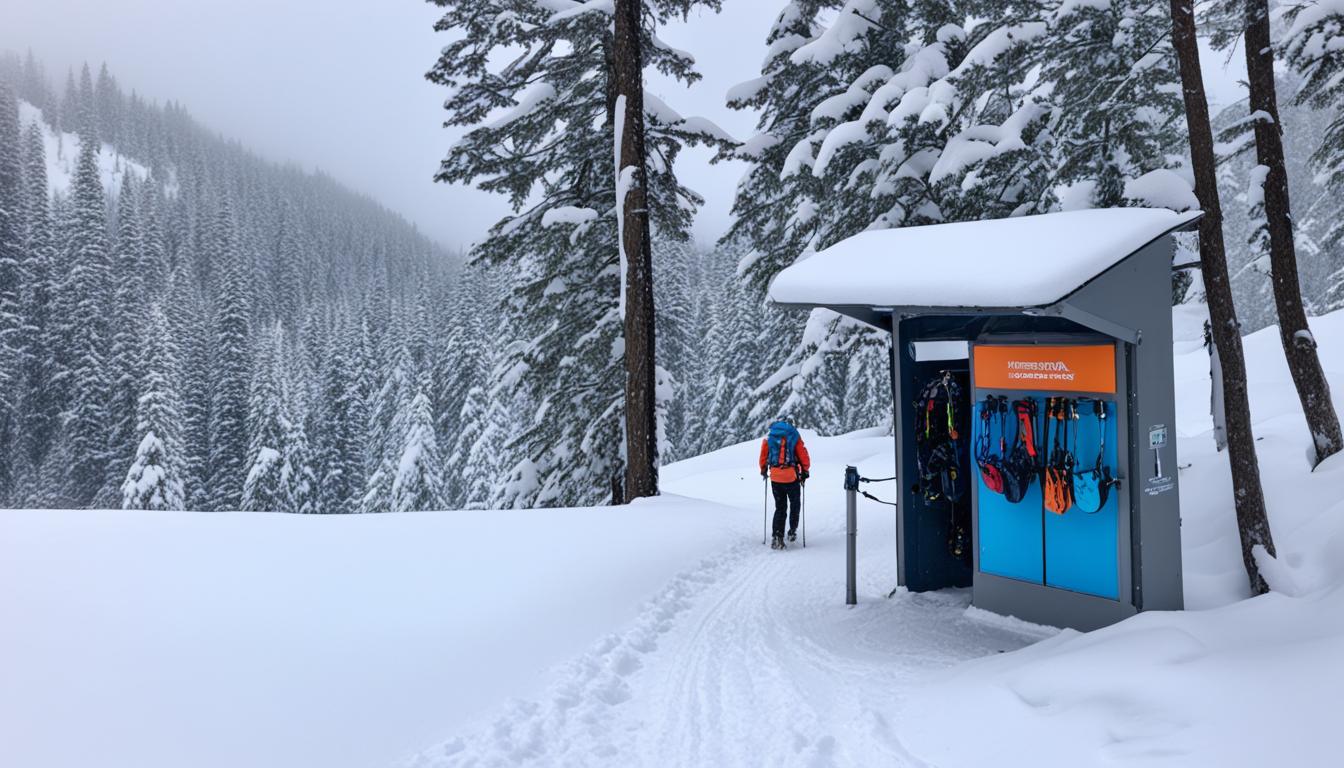Getting ready for your next ski adventure and eyeing new gear? The right equipment boosts your fun and skill on the slopes. It’s key no matter your skiing level. In this guide, you’ll learn how to pick gear that fits your needs, ensuring a great time up on the mountains.
Key Takeaways:
- Consider your skill level when selecting ski gear
- Pay attention to factors like sizing, shape, and flexibility when choosing skis
- Find the perfect ski boots that offer both comfort and performance
- Don’t forget to choose the right accessories for safety and convenience
- Weigh the pros and cons of renting ski equipment vs. buying
- Explore different buying options to find the best place to purchase your ski gear
Understanding Your Skill Level: A Guide to Choosing Suitable Gear
Before you start skiing, think about your skill level and the gear you need. Are you just starting and need the best ski equipment for beginners? Or maybe you’re experienced and looking for ski gear essentials? The right gear makes your time on the slopes better.
For beginners, focus on basic gear that makes learning easy. Look for skis that are short, flexible, and wide for stability. Get boots that are soft and support your ankles well to help you learn faster.
If you’re more advanced, you’ll want specialized gear. This might mean skis for special terrains made with unique materials. Investing in gear that matches your skills is important for a great experience.
Finding the Right Balance
Finding the right gear means thinking about what you love about skiing. Do you live for speed or prefer taking it easy, enjoying the view? Matching your gear to your skiing style is key.
Knowing your skills helps you pick gear that’s just right for you. It’s not about having the newest gear. It’s about gear that fits your style and helps you have fun and do well.
“Skiing is a sport that combines skill, technique, and enjoyment. Choosing the right gear is essential to ensure you have the best experience on the slopes.” – Jane Davis, Professional Skier
| Beginners | Intermediates | Advanced |
|---|---|---|
| Shorter skis with soft flex | Versatile skis for various terrains | Specialized skis tailored to specific conditions |
| Softer flex boots for comfort | Boots with moderate flex and performance | Performance-oriented boots with enhanced support |
| Basic equipment without advanced features | Higher-quality gear with improved performance | Premium gear with top-of-the-line technology |
Personalizing Your Gear
It’s important to try different gear to find what you like. Skiers have different needs, and choosing the right equipment is personal. Don’t be afraid to try new things and get advice from experts.
Always put comfort and safety first when picking your gear. Good gear that fits well and suits your style not only makes you a better skier but also makes skiing more fun.
Now you know why skill level matters when choosing gear. Next, we’ll look at how to choose the right skis based on several important factors.
Choosing the Right Skis: Factors to Consider
When skiing, choosing the right skis is key. The correct skis can boost your performance and the joy you get from skiing. I’ll guide you through key things to look at when picking your skis. This will help you make a choice that fits your style and preferences.
Sizing and Shape
Finding the right size and shape for your skis is important. Your skis’ size should match your height, weight, and skill. For more control, use shorter skis. Long skis provide stability and float well on powder. Skis also come in various shapes, each with its own benefits for performance and versatility.
“The right size and shape of skis can greatly impact your skiing performance and enjoyment on the slopes.”
Flexibility
Consider the skis’ flexibility too. It’s about how they bend when under pressure. Stiff skis are great for speed and hard slopes. Softer skis are easier to handle and are better for playful skiing or if you’re just starting out.
Performance Characteristics
It’s crucial to know the skis’ performance traits. Skis are made for different types of skiing, such as carving or deep powder. Look at factors like ski width and camber profile to find skis that match your skiing style and the conditions you’ll be in.
Seek Expert Advice
When in doubt, talk to ski pros or experienced skiers. They can share their knowledge to help you make a good choice. Also, consider trying out different skis at demo days or rental shops. This can help you find the best fit for you before buying.
Thinking about these factors will help you find the perfect skis. Always focus on what works best for you, not just the newest or priciest skis. It’s all about picking skis that match your experience level, style, and where you’ll be skiing.

Skiing is exciting, and the right gear is vital for a good time. Next up, we will dive into ski boots. We’ll talk about why a proper fit, the right materials, and extra features matter. This is all key for comfort and top performance while you ski.
Finding the Perfect Ski Boots: Comfort and Performance Matters
Choosing the perfect ski boots is key for a comfy, high-performing day on the slopes. They should give good support and control. With the right boots, you won’t feel any discomfort or pain while skiing. Here, I’ll give some tips on picking the best ski boots for you.
Consider Boot Flex
The flex of a ski boot is crucial. It shows how stiff the boot is and is rated by numbers. High-flex boots are great for advanced skiers, offering top performance. Lower-flex boots are better for beginners or those valuing comfort. They give more wiggle room.
Get the Right Size
Finding the right size is vital for a comfortable fit. Your ski boots should be snug but not painfully tight. There should be some wiggle room for your toes, and you should be able to move your ankle freely. If in doubt, a pro boot fitter can help nail down the perfect fit.
Explore Customization Options
Ski boots can be made to fit you perfectly. Heat-moldable liners, adjustable buckles, and custom insoles are common features. These options can help your boots feel tailored to your unique foot shape and needs, boosting comfort and performance.
Since everyone’s feet are different, choosing the right ski boots takes some trial and error. Trying out various brands and models is key. Expert advice is also invaluable in making the best choice. So, don’t be shy about asking for help.
The ideal ski boots will give you the confidence to conquer any mountain. Look for a pair that balances comfort and performance well. This effort will pay off in maximizing your enjoyment of the ski season. Enjoy the adventures these boots will take you on.

Poles and Other Essential Accessories: What to Look For
Skis and boots should be your main focus, but don’t forget about important accessories. These help keep you safe and more comfortable on the slopes. We’ll look at why poles are important aside from helmets, goggles, and gloves.
Choosing the Right Ski Poles
The right ski pole length is key. A good rule is they should reach your chin with your ski boots on. This length helps with balance and control. You also need to think about the material. Aluminum poles are tough and cost less. Yet, carbon fiber poles are lighter but cost more. Pick the best for your budget and needs.
Selecting the Perfect Helmet
A helmet is a must for safety on the slopes. Make sure it’s certified for skiing and snowboarding. It should fit you snugly for the best protection. Look at ventilation, adjustability, and any extra features like headphones or goggle compatibility.
Goggles and Gloves for Optimal Performance
Goggles shield your eyes from the elements. Get ones that fit well and won’t fog up. The color and type of lens should match the light conditions where you’ll ski. When it comes to gloves, focus on keeping warm and dry. Choose insulated gloves with waterproofing for the best protection.
| Accessories | Features to Consider |
|---|---|
| Ski Poles | – Length: Reach your chin when standing upright with ski boots on – Material: Aluminum or carbon fiber |
| Helmet | – Certified for skiing and snowboarding – Proper fit – Ventilation and adjustability – Additional features like built-in headphones or goggles compatibility |
| Goggles | – Snug fit – Anti-fog coating – Lens color and category suitable for lighting conditions |
| Gloves | – Warmth and insulation – Waterproofing – Dexterity |
Additional Accessories to Consider
Don’t overlook these extra items for a better ski trip:
- Base Layers: They’re for staying dry and warm under your main gear.
- Neck Gaiter or Balaclava: These keep your face and neck warm and safe.
- Hand and Toe Warmers: Adds heat when it’s really cold out there.
- Ski Socks: Keep your feet comfy and prevent blisters.
- Ski Backpack: It’s a must for carrying all your things on the mountain.
Thinking about these extras can make your skiing much better. And always keep safety first.
Considering Rental Options: Pros and Cons
Renting ski gear is smart for new skiers or those who ski now and then. It’s worth looking at the good and bad of renting. Consider costs, how easy it is, and the gear’s quality. This helps you choose what’s best, rent or buy.
The Pros of Renting Ski Gear
There are many reasons renting ski gear is a great idea:
- Cost-effectiveness: If you ski just now and then, renting is cheaper. You don’t have to pay a lot upfront and for upkeep.
- Convenience: No need to lug gear back and forth. You grab your stuff at the resort and drop it off there too.
- Flexibility: Want to try different skis or brands? Renting lets you do that without buying first.
- Expert guidance: Rental places have experts. They suggest the best gear for your skill and likes.
The Cons of Renting Ski Gear
But, there are downsides to renting. Here are a few to keep in mind:
- Limited selection: Sometimes, rental stores don’t have all the newest gear or many choices. This is more common during busy ski seasons.
- Quality concerns: The gear might not be perfect, especially if it’s seen a lot of use. Though, good stores look after their stuff, there could be something off.
- Long-term costs: If skiing is a regular thing for you, renting might get expensive over time. It might be smarter to buy if you’re in this for the long haul.
The rent versus buy choice comes down to how you ski, your budget, and what you like. Think about how often you ski, your skill, and if you’ll be doing this for a long time. Trying out rental gear first is a good idea. It lets you see if it suits you before a big decision.
Now, we’ll check out where you can purchase ski gear. We’ll look at all the places you can find what you need.
Where to Buy Ski Equipment: Exploring Your Options
Finding the right place to buy ski equipment is crucial. You’ve got different options to explore. This includes looking at local stores, the online scene, and even second-hand markets. Let’s dive into each choice and see what they offer.
Local Ski Shops
Local ski shops are a great place to start. They have a lot of gear for you to check out up close. This means you can try and test it before buying. The staff know their stuff and can really help you choose what’s best for you. Plus, shopping locally supports the community you ski in.
Online Retailers
Shopping online is another easy way to find ski gear. You can see a huge variety without leaving home. Online prices can be very competitive. And there are often sales or special offers to be found. Just be sure to read up on items carefully before you buy. Look at reviews and sizing guides to make sure what you get is right for you.
Second-Hand Markets
Looking into second-hand options can save you a lot of money. Many online platforms and local groups offer used gear. This can be a perfect way to find affordable quality, especially for new skiers. Remember to check the gear’s condition well. And always ask about its previous use.
Choosing where to get your ski equipment depends on what matters most to you. Think about your budget, how easy it is to get what you want, and which gear you actually need. No matter where you buy, always keep an eye out for quality and a good fit. This will help make your skiing days fun and safe.
$(document).ready(function(){
$('h3').css('font-weight', 'bold');
});
Conclusion
In this article, I’ve shared important tips on picking the best ski gear. Whether you’re new to skiing or a pro, knowing your skills and budget is key. This way, you’ll choose wisely when you shop for ski equipment.
The right skis, boots, and accessories are crucial for your comfort and safety. Focus on factors like size, flex, and if you can customize them. Also, think about getting poles, helmets, goggles, and gloves to make skiing better.
Deciding if you should rent or buy ski gear depends on several factors. These include the cost, how easy it is, and the gear’s quality. Look at local shops, check online, and visit second-hand markets to find the best deals.
With the advice from this article, you’ll know how to pick the ideal ski gear. Having the perfect equipment means you’re ready for any slope and can have an amazing time skiing.
FAQ
What should I consider when choosing ski equipment?
When picking ski gear, think about your skiing level, what type of skiing you’ll do, and what you like. Consider the right skis, boots, and accessories for your needs.
How do I determine the right size of skis?
Skis should fit based on your height, weight, and how well you ski. It’s best to get help from a ski shop. They’ll find the best size for you.
What factors should I consider when choosing ski boots?
Ski boots must have a good flex, be the right size, and have options for adjustments. Make sure the boots are comfortable and support you well for better skiing.
How important are poles and other accessories?
Poles, helmets, goggles, and gloves are key for a great ski day. Poles help with balance and turns. Helmets, goggles, and gloves keep you safe and warm.
Should I rent or buy ski equipment?
It’s good to rent if you’re new to skiing or ski just sometimes. This saves money and hassle. Buying gear, however, means having stuff made just for you.
Where can I buy ski equipment?
You can buy ski gear at local shops, online, or from second-hand places. Look into each to see what fits your needs and wallet best.




